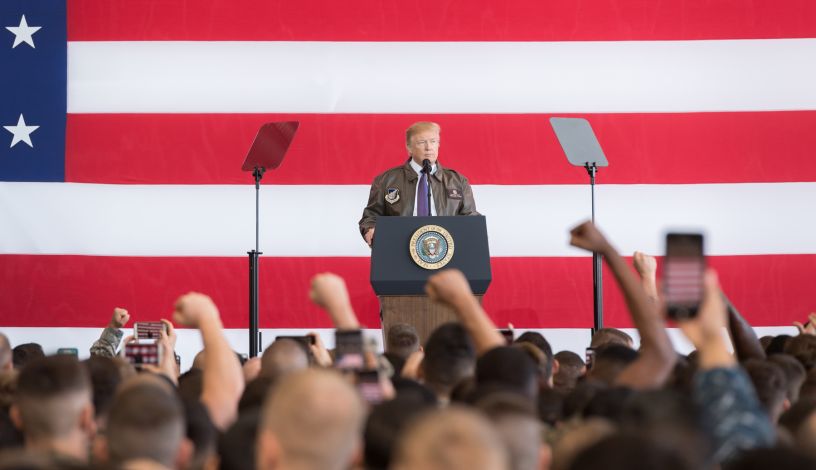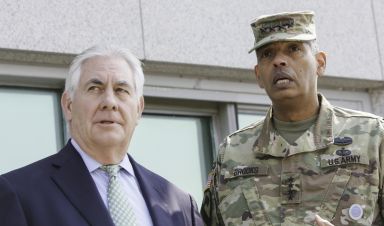Paranoia and contradiction define Trump’s National Security Strategy
9 January 2018
US President Donald Trump released the National Security Strategy (NSS) last month, providing an important insight into his administration’s worldview and its stance on global security issues. Ursala Knudsen-Latta and David Alpher explore some of the key pillars that define the strategy and what they might mean for US engagement abroad.
With ‘policy’ increasingly seen as the purview of disconnected bureaucrats, President Trump’s recently released National Security Strategy (NSS) may not get much public or media attention outside of Washington DC. Because the NSS doesn’t specify doctrine, provide tactical guidance, or specify diplomatic policy, it is easy to dismiss as vague and irrelevant. However, the NSS is one policy document that really matters: it is one of the pillars of American foreign policy. It is the foundation of how America plans for crisis, and the face it presents to the wider world. Each administration creates a new one to outline its priorities and how it will respond to security threats.
Although the NSS is more philosophical than operational, it is a durable symbol of the tone and priorities that each president intends to follow. It describes the main threats the United States faces and explains how it should react as a nation. Because the NSS is the mind that guides the body, public servants, allies and adversaries as well as the American people use it as a reference point.
The administration’s threat assessment: aggression and paranoia
By definition, security threats and responses are central to the NSS. However, this administration breaks with the precedent of the last 15 years, with a tone of overt belligerence and a realpolitik worldview reminiscent of the Cold War. Russia and China are cast as opposing powers in a clash of civilizations. The overall tone of competition and aggression gives the impression that America is in a war-making posture, ready to pounce, rather than peaceful or cooperative by nature. Cyberattacks and terror threats are listed alongside the Russians and Chinese, painting a landscape in which danger is ever-present and endemic at every level—although notably, climate change is absent. The NSS goes beyond an alert to potential threats and edges towards the realm of paranoia, however, when it discusses the notional ‘deep state’—a startling illustration of how this administration frames America’s internal divisions as a security threat on par with external ones.
The dangers of inconsistency
The NSS provides an opportunity for each administration to move through a term in office with clear core foreign policy principles and guiding priorities. However, there is a worrying contradiction between the NSS and President Trump’s own rhetoric and action—an unprecedented situation in which the president and his administration appear to be going in markedly different directions.
Contradictions are rife. The NSS lauds diplomacy while the Secretary of State is accused of dismantling the State Department. Global engagement is praised at times, while decried as a dangerous waste of time at others. Partnerships and multilateralism are good—but only if they serve US interests that are defined in isolationist terms. Perhaps more worrying is that the NSS applauds human rights and democracy, while those same words risk being removed from mission statements in USAID and the Department of State. At the same time, the US continues to reinforce repressive and autocratic regimes that flout these same values.
The result is clearly a trap. Career public servants, who use the language of documents like the NSS to guide their daily work, face a situation in which written policy is routinely contradicted by the president’s words and actions, as well as by those of his cabinet and advisors, who may also contradict the president to moderate the discrepancy. This is particularly worrying during a crisis, as the ability to respond correlates directly with the amount of forethought that goes into policy, internal coordination and the consistency with which a government holds to its own core values. Inconsistency and unpredictability also create confusion in the international community, which currently doesn’t know what to expect from the US. This lack of clarity translates into erratic responses, whether from allies who can no longer count on US leadership, or from rivals who are well positioned to take advantage of a confused American approach (as Putin, Assad and Rouhani have done in Syria).
Much of the world considers the contradiction between the president’s speech and the ideas enshrined in documents like the NSS to be a statement in itself. Since the discrepancy is clear, official policy is interpreted as deliberate misdirection – an action made with one hand to distract from what’s being done with the other.
Growing international mistrust over US intentions is bad for America. When US ideals, like a commitment to human rights and democracy, are sullied by perceptions of inconsistency and insincerity, the damage is considerable.
Espousing democracy and human rights while actively undermining them when it is convenient to US interests gives America’s rivals license to behave in similar ways, further undermining the global norms that have been the foundations of international stability since World War II.
Where to from here?
Future iterations of the NSS – presidents are not limited to just one – and other top-line policy documents yet to come still represent an opportunity for the US to set a new course and provide clarity to its diplomats and the global community. Many of the policies outlined in the current one may be dangerous, as other commenters have reported at length, but there are also good points to highlight such as the commitment to reducing conflict and the commitments to human rights and democracy. These, of course, need to be kept and strengthened – but which hand should we watch?
Photo: White House/Andrea Hanks


